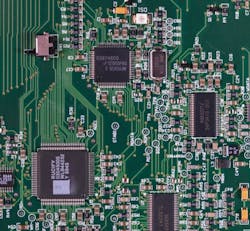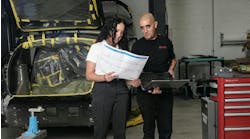The idea that many points of data are better than one is not new. It is in fact among the oldest ideas in Western philosophy. Aristotle wrote in Politics that the many, when together, can have abilities far beyond even the most excellent individual.
While probably not the sort of thing Aristotle had in mind, the value of that pooled information is the principle behind Protech Automotive Solutions’ ID3 calibration identification solution. Unveiled at the 2022 SEMA Show, ID3—pronounced “ID cubed”—uses artificial intelligence (AI) and machine learning to identify calibration needs in a repair. While that service exists in many forms today, Protech Vice President of Product Development Don Mikrut says that the key difference with ID3 is that instead of merely returning what kind of calibrations might be needed, ID3 is able to use its knowledge base to deliver more accurate assessments quickly.
“We start to triangulate all that data through the algorithms and the machine learning that we've developed, to come back and say, based on your pre-scan, and the estimated damages, and the OE procedures and knowledge base, we've been able to triangulate this,” says Mikrut, hinting at the source of the three in ID3’s name. “Every line of that estimate comes back and tells you this is what needs to be calibrated on this vehicle based on the damages.”
To know that this process happens in milliseconds is to partially understand the genesis of this project and its need in the marketplace. With the advent of ADAS systems, shop owners were needing to devote time to a manual research process to know what systems needed to be calibrated on a vehicle for any given repair. A diagnostic scan could reveal what systems were present but not necessarily which ones were impacted by damage. That leaves a process open to interpretation and judgment calls.
This is what Protech was hearing from its collision customers. A research & development team led by Vice President, Protech Technology Innovation Chris Gutierrez was tasked with solving this problem and the result was ID3, which had been rolled out in approximately 1200 locations by the end of 2022. The team leaned on “30-plus years of building a knowledge base,” according to Mikrut, that encompasses Protech’s acquired expertise as well as data from OEs for ID3 to draw on.
“ADAS ID3 builds on our expertise and history in the vehicle diagnostic industry by revolutionizing the identification of calibration and repair needs, thus saving our technicians and partners time and money,” said Gutierrez at the time of the product’s release. “Protech’s focus is to fix vehicles the right way the first time.”
And ID3 isn’t just a one-time search. It continues to work as a vehicle goes through the repair process and is equipped to handle any contingency.
“Your estimate can be five lines, it could be 100 lines,” says Mikrut. “And so our algorithm, the way we do it is that we triangulate every one of those lines to make sure that we've cross-referenced everything in that estimate. And not only from the preliminary estimate … as that estimate evolves to the full repair plan, and the finalized repair bill, we run it through that algorithm again so our machine learning continues to go through if there is a chance that as they tear the car out and find additional damages that our algorithm will come back and give them an additional calibration that may be necessary on more internal damages found as the car continues through the repair plan.”
The difference that thoroughness makes is evident in the performance ID3 customers are seeing as the tool rolls out. According to CCC’s Crash Course report prepared by industry analyst Susanna Gotsch, in the third quarter of 2021 7.1% of all appraisals included a calibration event. The results Protech is seeing from ID3 report that more than 30% of vehicles report a needed calibration.
Bridging that gap is vital to completing safe, quality repairs. It’s simply unknown what the nature of those missed calibrations is. It may appear that the systems are working but not working as intended.
“What it means is that they're not within the tolerances of where the OEM needs them to be,” explains Mikrut. “So they may function, but not function exactly as they were designed. They may be late to notify you of lane departure. Are they emergency braking, because it's not at the right angle?”
To get ID3 working in the hands of customers, Protech has partnered with diagnostic tool providers Autel and Bosch for a seamless integration with those devices. How it works is the diagnostic information is sent to ID3, which goes through the triangulation process Mikrut outlined, and then returns a report either in an email or PDF format to the customer.
ID3 is one among an array of solutions Protech offers to its customers. The company also offers mobile diagnostics and calibrations, static calibration centers, virtual support and more. Protech realizes that continued innovation is essential to survive as the pace of vehicle development is not going backwards.
“It's not only telling you what needs to be calibrated, we tell you how it needs to be calibrated,” says Mikrut. “And we're advancing that as the vehicle advances so that they understand it. Because the last thing people need to know is, ‘Hey, look, I tried to do a dynamic, it failed. Oh, no, I can't do it dynamic. What do I do?’ That's where our information will come back and say, well, now you have no choice but to do static.”
Even with the swift advancement of vehicles, a platform like ID3 is in theory inherently equipped to deal with the changes. The more vehicles that get scanned the more data there is and the more machine learning that takes place. Every year that gets added onto Protech’s 30-plus years of experience means more knowledge for the base.
“We're always doing the research on the newest and latest vehicles,” says Mikrut. “So, because we have great relationships with OEMs and what we do with getting access to their repair procedures, their information, we're constantly looking at the [2023 vehicle models] before they come out. So as soon as that information was there, we're building the database, right? Because we need that information because, in a collision space, we can see a car that's brand new, say he just drove off the lot and someone hit him, we've got to make sure that we're always on the cutting edge. And so we've got a team of researchers that are doing that on a regular basis.”





